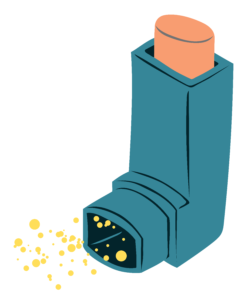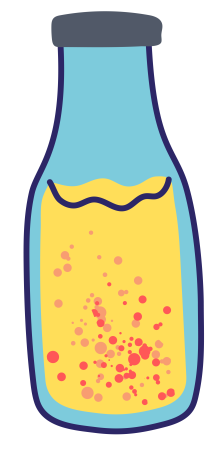If you’ve ever used Metered Dose Inhalers (MDIs) then you’ll likely know the very first step that’s too easy to forget: Shake the inhaler for 5 seconds. But only ~20% of people remember to shake the inhaler before a puff [1]! In this post, we’ll discuss why we need to shake inhalers before use, what happens if we forget, and a key tip for the right way of shaking inhaler.

Decades of past research have made it common knowledge that when using MDIs, it’s critical to follow the steps of inhaler use correctly so that enough medication gets dispensed from the MDI and we maximize the amount reaching the lungs [2-8]. Each correct step adds to the drug deposited in the lungs, but with every mistake, we lose some on the way (mouth, throat, large airways, or exhaled out). From the patient’s point of view, there’s no telling where the medication went, no way to measure it.
So let’s delve a little bit deeper into the science behind drug delivery in a series of posts called “How to use inhalers.” Part II looks at the inhaler shaking for dose preparation.
Why should I shake the inhaler?
If you read the inhaler package instructions for correct use, most of them carry a message, “shake the inhaler vigorously for 5 seconds”. The reason is that the inhalers are formulated with drugs in a suspension format with a propellant. The propellant aerosolizes the medication to millions of tiny particles ejected from the MDI mouthpiece when we depress the canister. There is a metering chamber in the MDI that releases a known volume of the drug and propellant mixture.

The problem here is that the drug and propellant mixture is usually not a homogenous solution, meaning when the MDI is not in use, the drug settles down in the canister while the propellant floats on top. For some drugs, the opposite happens where the drug floats to the top, and propellant remains on the bottom. By shaking the canister, the drug and propellant are forcefully mixed together such that the canister now contains an evenly distributed mixture. Just like shaking your bottle of dressing before drizzling it on your salad!
The catch with MDIs is that the metering chamber is actually filled with the mixture for the next dose right after we depress the canister. So the whole purpose of shaking the MDI right before actuation is to fill up the chamber with the right concentration of drug for our next dose.
Figure below shows an illustration of the canister for two cases [9], a. when we don’t shake the MDI and b. when we shake the MDI for 5 seconds.


As you can see, shaking the MDI vigorously for 5 seconds makes sure that the dose is prepared properly for the next puff. Some MDIs are not suspension-based but rather solution-based, that is, the medication and propellant are mixed in a homogenous solution that doesn’t separate. So you don’t need to shake those MDIs. The MDI package instructions state whether the inhaler needs to be shaken before use. Fortunately, there’s no harm[9] even if you do shake them out of habit!
How does CapMedic help?
Our smart inhaler device CapMedic can help you remember to shake your inhaler before every puff. CapMedic provides live feedback to remind and help with proper MDI shaking during use (in addition to the other steps of orientation, coordination, and inhalation) and provides tips on the smartphone app on how to correctly shake MDIs. Our early pilot study results show that children (aged 8+ years) when taught correct inhaler use with CapMedic remembered to shake the inhaler correctly 100% of the time with feedback from CapMedic [9].

Your CapMedic smart inhaler reminds you to shake your inhaler and provides audio-visual cues to guide you through the vigorous shake so that your medication is prepared and ready for every puff!
Quick critical tip after shaking!
Note that just like your dressing bottle, the MDI contents quickly begin to settle down after shaking. So we usually have a short window of about 5-10 seconds [9] in which we should take our medication. If we wait too long to take our puff after shaking, the mixture is back to the original composition. So remember to shake your MDIs for 5 seconds and quickly take your puff right after!
Here’s what happens when we wait too long to take the puff after shaking the inhaler:

Of course, the other steps of inhaler use (orientation, inhalation flow, coordination timing of actuating the MDI and breath-hold) also contribute toward maximizing the drug deposition in the lungs. We’ll discuss each step one-by-one in the upcoming posts.
References
- Paronyan, E., et al. “Utilizing Capmedic Electronic Device to Measure and Improve Inhaler Technique in Clinic.” C32. FACTORS IN ADHERENCE AND CONTROL OF ASTHMA. American Thoracic Society, 2020. A4786-A4786.
- Capstick TG, and Clifton IJ: Inhaler technique and training in people with chronic obstructive pulmonary disease and asthma. Expert Rev Respir Med. 2012;6:91–103.
- RubinBK: What does it mean when a patient says, ‘‘My asthma medication is not working?’’ Chest. 2004;126:972–981.
- Roche N, Chrystyn H, Lavorini F, and Agusti A: Effectiveness of inhaler devices in adult asthma and COPD. EMJ Respir. 2013;1:64–71.
- Melani AS, Bonavia M, Cilenti V, Cinti C, Lodi M, Martucci P, Serra M, Scichilone N, Sestini P, Aliani M, and Neri M: Inhaler mishandling remains common in real life and is associated with reduced disease control. Respir Med. 2011;105:930–938.
- Laube BL, Janssens HM, De Jongh FHC, Devadason SG, Dhand R, Diot P, Everard ML, Horvath I, Navalesi P, Voshaar T, and Chrystyn H: What the pulmonary specialist should know about the new inhalation therapies. Eur Respir J. 2011;37:1308–1331.
- Price, David B., et al. “Inhaler errors in the CRITIKAL study: type, frequency, and association with asthma outcomes.” The Journal of Allergy and Clinical Immunology: In Practice 5.4 (2017): 1071-1081.
- Biswas, Rajoshi, Nicola A. Hanania, and Ashutosh Sabharwal. “Factors determining in vitro lung deposition of albuterol aerosol delivered by Ventolin metered-dose inhaler.” Journal of aerosol medicine and pulmonary drug delivery 30.4 (2017): 256-266.
- Hatley, Ross HM, et al. “Variability in delivered dose from pressurized metered-dose inhaler formulations due to a delay between shake and fire.” Journal of aerosol medicine and pulmonary drug delivery 30.1 (2017): 71-79.


Excellent explanation and pictures/figures!
Unfortunately, many nursing and medical staff members also have no idea of the correct usage of an MDI.
The CapMedic also seems like a brilliant idea! Well done!
I will have to see if it is available in Australia.
Leave a comment